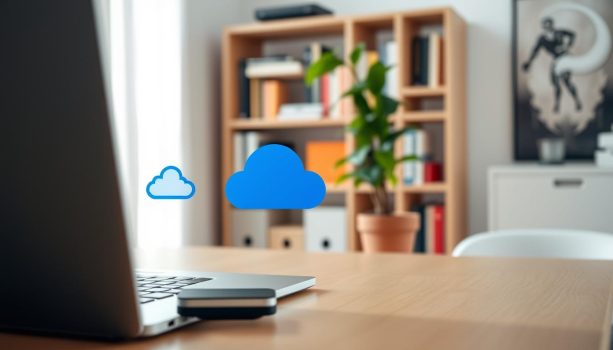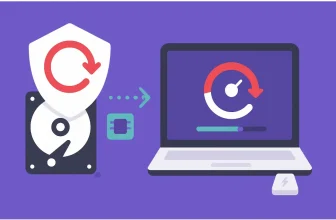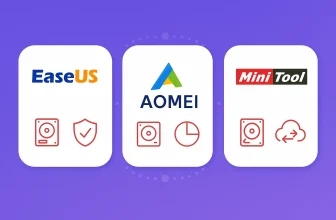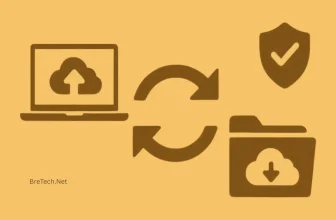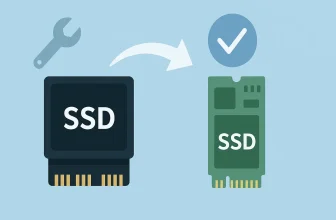About one in four businesses never reopen after a disaster, per the U.S. Small Business Administration. For students and SMEs in Pakistan, one data loss can end a semester or stall sales. This guide gives you a simple routine that fits local budgets and bandwidth.
BreTech helps you set up fast local copies for quick restores and a secure off-site copy for disasters. With 3-2-1, encryption, and automation, you can cut risk without big spend. You’ll also see where tools like AOMEI Backupper, EaseUS Todo Backup, Ashampoo Backup Pro, and MiniTool ShadowMaker fit for Pakistan users. (We sell these.)
We focus on preventing data loss and keeping data safe for classrooms, labs, and offices in Pakistan.
Assess Your Data and Risks — what to protect and why it matters

First, get a clear view of your data. Map what you have, where it lives, and how often it changes. This audit is the base for smart protection.
Identify critical data for students and SMEs
Students and teachers: thesis drafts, research data, lab results, notes, designs.
SMEs: customer records, finance, HR, contracts, IP, marketing plans—across laptops, desktops, NAS, and servers.
Common causes of data loss to plan for
Most losses come from accidental deletion, drive failure, buggy updates, and ransomware. In Pakistan, add risks like power issues, theft, and floods. Good protection reduces these risks.
Set recovery objectives
Decide RPO (how much data you can lose) and RTO (how fast you must recover). Document them, ensure enough backup space, and enable alerts.
How to Avoid Data Loss

Keeping files safe can be simple. Follow the steps below and use trusted tools BreTech offers in Pakistan.
Adopt the 3-2-1 backup rule and hybrid strategies
Keep three copies, on two different media, with one off-site. A practical setup:
- A local image to an external HDD or NAS using AOMEI, EaseUS, Ashampoo, or MiniTool.
- A second, encrypted copy off-site (secure cloud or remote location).
Vendor notes: these platforms support backup encryption (AES-based). EaseUS supports AES-256, AOMEI supports AES, and Ashampoo supports strong AES encryption.
Tip: Browse our File & Folder Backup tools for straightforward file-level jobs, and Disk & System Imaging solutions when you need full PC images.
Choose appropriate backup frequency and methods
Let RPO guide frequency: daily for office files and student work; hourly for high-change data; more frequent for finance or key databases. Mix full + incremental/differential to stay fast and efficient.
Protect backups with encryption and access separation
Encrypt backups (AES), keep backup credentials separate, and avoid sharing the same admin accounts between production and backup. These habits block casual access and limit attacks.
Include endpoints (laptops/desktops) and shared data
Roaming devices hold critical work. Schedule automatic endpoint backups (system images + files). For shared drives or team folders, add a sync/mirror job for rapid duplication alongside your true backups.
Explore Sync & Mirror tools for day-to-day duplication, alongside your main backups.
Quick Planner
| Need | BreTech guidance | Example tools we sell | Benefit |
|---|---|---|---|
| Fast local restores after power/ISP issues | Keep a recent system image on USB HDD/NAS | AOMEI Backupper, MiniTool ShadowMaker, Ashampoo Backup Pro, EaseUS Todo Backup | Recover files or a full PC in minutes |
| Off-site resilience (theft/flood) | Maintain a second, encrypted copy off-site | EaseUS Todo Backup, AOMEI Backupper (to remote/NAS/cloud), Ashampoo Backup Pro | Meets 3-2-1; survives site disasters |
| Ransomware rollback | Use versioning/retention and separate access | Supported across listed tools | Safer restores and rollback of changes |
| Roaming laptops (students/staff) | Scheduled image + file backups | AOMEI/EaseUS/MiniTool/Ashampoo | Captures off-network work automatically |
| Bare-metal recovery | Create bootable rescue media in advance | AOMEI Backupper (Universal Restore), MiniTool WinPE, Ashampoo Rescue | Cuts RTO with ready-to-boot recovery |
Implement and Maintain Your Backup Routine — tools, testing, and best practices

Strong routines protect your data daily.
Automate backups and monitor health
Create scheduled jobs, enable email alerts, and review logs weekly. For PCs and servers, AOMEI Backupper and EaseUS Todo Backup support system/file/disk images and scheduling; Ashampoo Backup Pro offers a simple wizard; MiniTool ShadowMaker adds clear options for backup scheme and verification.
Keep software updated. Leave 20–30% free space on backup storage to reduce failures.
Test restores and run periodic drills
Backups are only proven by restores. Do monthly file/app restores and a quarterly full-system test. Tools provide bootable rescue media to speed recovery on dead PCs. (AOMEI Universal Restore; MiniTool/Ashampoo WinPE rescue.)
Versioning, retention, and long-term storage
Keep short-term versions for fast rollbacks and archive older copies. Encrypt portable drives taken off-site and document who has access.
Documentation, training, and when to call experts
Maintain a simple runbook: what is backed up, where it lives, who can access it, and steps to recover. Train teams to save work in protected locations and follow a short emergency checklist.
Conclusion
Start small, automate early, and check often. A hybrid 3-2-1 plan with encrypted local images plus an off-site copy keeps work flowing for Pakistani students and SMEs. When ready, shop the right tools with genuine licenses, fast email delivery, and local payments:
- Explore File & Folder Backup software in Pakistan
- Explore Disk & System Imaging tools for full PC backups
- Explore Sync & Mirror utilities for everyday duplication
- If something’s already gone, try Data Recovery tools
Further Reading
- Best Backup Software in Pakistan (2025)
- Best Backup & Sync Software in Pakistan (2025)
- Best Cloud Backup Solutions for Business & Home in Pakistan (2025)
- AOMEI Partition Assistant vs Backupper in Pakistan (2025)
- How to Recover Deleted Files from Hard Drive in Pakistan
- How to Fix Corrupted Files in Windows
FAQs
Q: How can I avoid data loss with a simple routine that fits Pakistani budgets and bandwidth?
A: Follow 3-2-1: a daily local image to USB/NAS plus a weekly encrypted off-site copy. Use incremental/differential schedules to save time and bandwidth. (All supported by AOMEI, EaseUS, Ashampoo, MiniTool.)
Q: What data should students and SMEs in Pakistan back up first?
A: Finance and customer files; active coursework/projects; email exports and designs; plus your system image for fast rebuilds.
Q: What causes most data loss, and how do I prevent it?
A: Human error, drive failure, buggy updates, and ransomware. Prevent with automated backups, version history/retention, surge protection/UPS, antivirus/EDR, and encrypted images.
Q: How do I set RPO and RTO for my backup plan?
A: Let the work drive the targets: daily for general files, hourly for high-change data, faster for critical systems. Reduce RTO with bootable rescue media and features like AOMEI Universal Restore (restore to different hardware).
Q: What is the 3-2-1 backup rule and why is it effective?
A: Three copies, two media, one off-site. Local copies give quick restores; the off-site copy protects against theft, fire, or outages. It’s a proven best practice.
Q: How often should I back up different systems?
A: Daily for office/student files; hourly for mailstores/databases; more frequent for finance. Use full + incremental/differential jobs.
Q: How do I protect backups from unauthorized access?
A: Encrypt images (AES), separate credentials, and lock down who can access backup storage.
Q: Do I need to back up cloud email and document suites?
A: Yes. Keep version history on, export key data regularly, and consider a separate backup if your compliance needs require it.
Q: How should I back up laptops and desktops used off-site or in labs?
A: Schedule image + file backups, keep a local copy for quick restores, and maintain an off-site copy for disasters. Create rescue media now so you can boot and recover later.
Q: What retention and versioning policy works for most teams?
A: A simple tier: intra-daily (as needed) for 7 days, daily for 2 weeks, weekly for 1 month, and longer-term archives off-site.
Q: Is the opening statistic reliable?
A: Yes—industry and government guidance commonly cite that roughly a quarter of businesses don’t reopen after major disasters. Strong backups and tested recovery reduce downtime.
